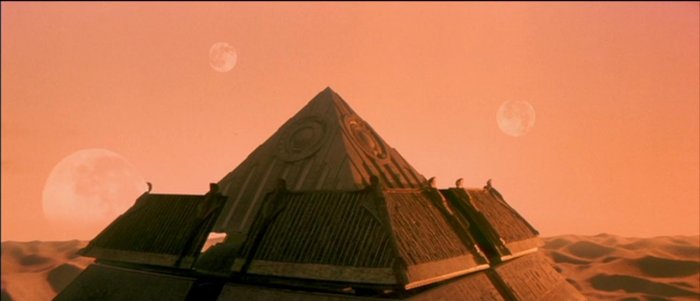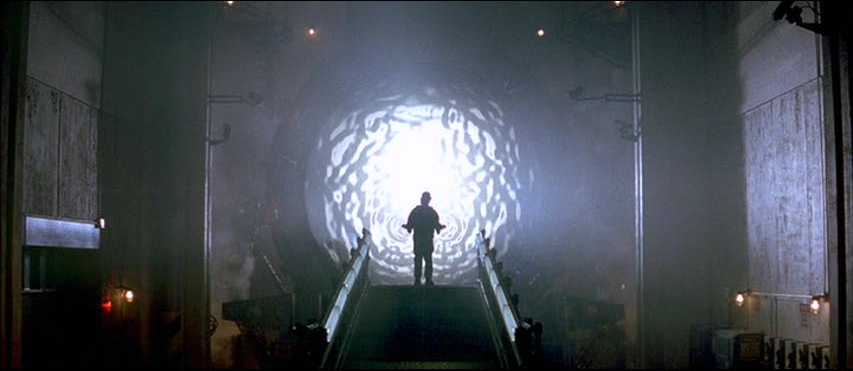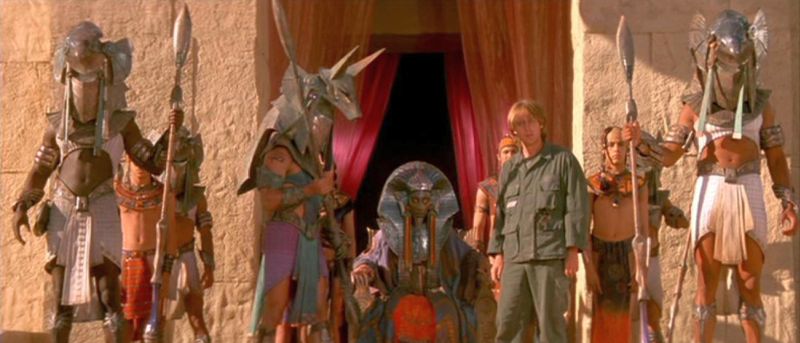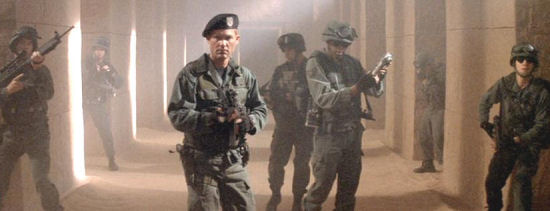Do you remember when you saw Stargate for the first time? For most people, they were introduced to it via Stargate SG-1, the longest running sci-fi series on television to date. For me, I knew of the series but never caught it because, at the time, it was still on Showtime. It all started when I was in middle school and found myself at Blockbuster on a Friday afternoon after school. I picked up Stargate, the movie, – on VHS, I might add – to watch that evening with the family. As I held it in my hand, I vividly recalled the TV spots that I had seen just before the film came out in theaters. I remembered a shot from the commercial, which has since become my favorite moment of the film. That memory was what made me pick up the movie in the first place. Who would have thought that Stargate, a fall of ’94 sleeper hit, which feels more like a summer movie, would become one of the biggest franchises of all time.
Stargate is about just that: the Stargate. The Stargate is a giant ring made of an unearthly mineral that was found on the Giza Plateau in 1928. When activated, it creates a portal to other worlds. In the film, we meet Dr. Daniel Jackson (James Spader). He is an Egyptologist who has run out of grants, has no job, no home and is not taken seriously in the academic community. Daniel is recruited by Catherine Langford (Viveca Lindford), who is working on the Stargate project. The initiative is being conducted by the Air Force to help translate hieroglyphs that have been found on the cover stone of the Stargate. Catherine was just a child when the Stargate was discovered in 1928.
Early on, we meet Jack O’Neil (Kurt Russell), a Colonel in the Air Force who has recently lost his son due to an accidental self-inflicted gunshot wound. Grieving over his son, Jack, himself, has suicidal tendencies. When he is reactivated into the Air Force, he becomes the leader of the Stargate Program.
As Dr. Jackson works on the hieroglyphs, he not only corrects the other translator’s work, but singlehandedly discovers that the symbols on the cover stone are not a part of any language but rather the symbols of star constellations. With this new information, the military is able to activate the Stargate successfully. Through the gate, a team travels to a desert world with three moons on the other side of the known universe. Henceforth, the sci-fi adventure commences with the team of soldiers finding themselves stuck on this world, meeting the natives, getting in trouble with a nasty alien foe named Ra (Jaye Davidson), and saving the day.
Originally conceived as a trilogy, Stargate is the brainchild of Ronald Emmerick who has directed such films as Independence Day, The Day After Tomorrow and his latest flick 2012. Now, personally, I do not like any of the films I just listed. They are cheesy popcorn flicks. Studios know that, come summertime, Emmerick is one of those directors who will make them a buck; however, I feel that Stargate was his best attempt at filmmaking. I liken it to M. Night Shyamalan directing The Sixth Sense; it’s a great film, but what happened to his career?
For this retrospect, I watched both the theatrical and extended cuts of the film. The extended cut is about nine minutes longer and offers a new beginning that was used as a flashback in the theatrical cut. This section involves more character moments, most of which do not add anything to the plot, with the exception of one short scene. This snippet offers a hint of insight into the hidden agenda on the mission. I really enjoy this film, but not as much as the series that follow. The three television series have a leg up on the movie because there is simply more time to develop story and characters. My favorite moment in the film by far is when Daniel is about to walk through the Stargate but he first stops to play with the event horizon and puts his head half way in. It not only looks cool, but this shows that he is more curious than the others and has a sense of wonder.
I quite enjoy the score by composer David Arnold. I know I like a piece of music when I find it very hummable, as the main theme is. Star Wars, Indiana Jones, and Lord of the Rings themes are also quite hummable. Stargate‘s music has the right timing, like a good-natured adventure such as Indiana Jones, while simultaneously knowing when to go with a darker tone.
There are a number of things that I really appreciate about Stargate: the first being that the creators made a point to use the real Egyptian language and hieroglyphics in the film. No faking for these guys. They did this for realism and because they knew the fans would appreciate it, which I do, because I am also a fan of history. I also appreciate how grounded in reality the film is. Rather than being set in the future, it is set in the present. The good guys are not swash buckling space pirates or super soldiers; they are the soldiers that we still have today. The city in the film is primitive and even the alien technology is based on the Egyptian style, which makes it very earthly. This is a tradition that the series continues on with.
Another thing worth noting is that the film does not take advantage of the trope found in most sci-fi, in which everyone speaks English. I feel one of the best aspects of the film is the language barrier that the characters have to overcome. It makes for good character moments like the peace offering of the chocolate bar, the feast scene that is a tribute to Temple of Doom, and the anti-smoking scene. I also notice that when Daniel has learned how to speak the language, the use of subtitles begins. In this way, Daniel is the eyes and ears of the audience.
Another thing I love about this film is the grandiose scale on which the backdrop is placed. Whole sets were built in the desert of Yuma, Arizona in the summer. The city of Nagada, the mine set, and the seven-story high entrance of the pyramid where the Stargate is located were all built on location. Having these sets built on location really helps with the scale of the film. As a relief from the heat and because they just did not have enough room, one of the biggest sets in the film, Ra’s ship, was built inside the Spruce Goose building in Long Beach, California, where Howard Hughes built his goliath planes. Other ways of making the scale of the film huge were to use such techniques as having 1800 extras on set. I also love the use of epic shots, which hearken back to films of yesteryear like Ben-Hur, The Ten Commandments and Lawrence of Arabia.
As for the acting, it is good, but not great. It is said that James Spader was not really interested in this film and just did it for the paycheck. That aside, he plays Daniel well as the nerd you want to root for. He makes you believe that Daniel Jackson is a man who can get obsessed with an idea or concept as he does with the idea that the pyramids were not built when everyone thought they were. Like all professor types portrayed in film, Daniel is clumsy and has allergies, which comes into play for times of humor.
Kurt Russell plays Jack straight; nothing too special here. In the series, Richard Dean Anderson expands the character and makes him quite likable. However, this is to be expected when you have multiple seasons to develop a character. I feel as if Russell plays Jack in a way in which the viewer would not really miss him if he died.
The film’s villain is Jaye Davidson, who plays Ra. As a dying alien, he took a young man as a host thousands of years ago and uses a special sarcophagus to stay alive. He has taken on the persona of the Egyptian god, Ra and adopted the Egyptian décor because he knows he will gain power this way. He shows off the power he has by protecting himself not with guards but by surrounding himself with children who are probably originally from the city and have been brain washed. Ra’s ship is also a pyramid that uses another pyramid as a landing platform. Although this has never been seen before, it has just shows off how big his ego is.
The “sidekick” character in this film is Alexis Cruz, who plays Skaara. He is one of the few actors who come back as the same character in the series. Skaara is the leader of the group of shepherd boys who look over the Mastidge, the beast of burden the natives use. Cruz portrays Skaara as a very curious boy, especially when it comes to Jack, and sometimes it gets the best of him. This is played out when he tries a cigarette for the first time. Skaara is one character who I view as being the cool kid in his group.
In her first American film, Mili Avital plays Sha’uri in Stargate. She is here to serve the love interest plot as well as a way to help Daniel break the language barrier. When Daniel and Sha’uri go looking for a symbol she drew for him, he learns how to speak their language and learns the story of how the natives came to the planet from Earth. Once Sha’uri knows the story, it is she who recounts the tale to the children. It is in this way that I see her as a teacher and the one who decides that a revolution needs to happen.
Erick Avari plays Kasuf and acts as the town elder. He is the father of Sha’uri and Skaara. Avari is skilled in a wide range of races, like Fred Armisen from Saturday Night Live. He is also one of the few actors to continue to portray his character in the series along with Alexis Cruz. Kasuf is a likeable, god fearing man who cares for his people. When Daniel shows everyone that the gods are false and that they do not need to be slaves anymore, one can tell that Kasuf questions what he has been worshipping and fearing his whole life. A sense of freedom comes upon him, which allows him to lead the charge at the end, when the whole city runs down the dune to save the day. To me, Kasuf is one of Stargate’s most memorable characters.
The visual effects have really held up well over the years. This is mainly because most of them were done practically using models, animatronics, and other unorthodox means. Even though Stargate came out post Jurassic Park, CGI was still in its infancy and the budget was not as large as a Spielberg film. The best effect done on the film in my book is the gate activation. The event horizon of the Stargate was made using both real and CG water effects. The use of real water looks great and holds up well because it is real. The effect used to show gate travel through space also looks good, even in today’s standards.
Stargate is not without its faults. One of the things I do not understand is this: if they knew they needed a seventh symbol to activate the Stargate, but didn’t know what it was, and there were only so many symbols on the Stargate, why didn’t they just try all the possible combinations to open the gate? This happens again when Daniel finds the symbols he needs to get home but the seventh is worn off. Again, just try different combinations. Another nitpick is that the soldiers are jocks picking on professors who are nerds. All I have to say about this is that we never left high school.

Some goofs you might be interested in spotting are that one can see the reflection of the boom, camera, and crew in the actor’s sunglasses in many shots. You can also see wires used for the gliders as they fly over the city. Why they did not at least paint out the wires for the Blu-Ray release is beyond me. Stargate has been released on Blu-Ray twice now, both looking like the same film transfer.
Some other blunders include some differences between the film and the series. They are as follows: In the film, the planet they go to is in another galaxy. In the series, it’s in the Milky Way. Jack’s son’s name in the film, as one can spot for a brief second on an award of some kind, is Tyler. In the series, his name is Charlie. The biggest change, however, is the mountain in which the military complex is located. In the film, it is located under Creek Mountain in Colorado. In the series, it is located under Cheyenne Mountain. Now, make no mistake; these flaws do not bother me. I just find them interesting flubs on the part of the show runners of the series since it was them who were basing a series on a film and probably watched the film many times over.
Let’s talk about the themes of the film for a moment. The first theme the film tackles is that knowledge is power. Ra has banned reading and writing so the humans brought through the Stargate would forget their past. This banishment of reading and writing is so much a part of the people’s psyche that when Daniel attempts to communicate with them by drawing in the sand, they fear the consequences of the act. Ra is always watching because, to them, he is their god. When Daniel learns the truth of who Ra really is and teaches this to Sha’uri, she in turn, teaches the children about their history. With this knowledge, the revolution starts.
At one moment in the film, Daniel is given Sha’uri as a wife. At the time he does not know that they are married in the eyes of the locals. However, when he discovers the truth about this, he accepts this and stays married to her. With our western ways, we may say, “How on earth can you stay married to a woman after you realize that she was a gift to you?” I have this to say about that: even though I may not agree with the concept of women as gifts, Daniel is an academic at heart and is able to recognize and respect a local custom. He would not want to offend them. What I think happens after the film has ended and life continues on, Daniel stays legally married to her while he gives himself the chance to fall in love with her. By our standards it’s all just paperwork. By the end of the film, it is obvious that Daniel has at least fallen in like with her. What happens between the film and the series is up to the imagination but I think we can tell that things worked out for Daniel and Sha’uri.
Another theme, which can be tied more closely to our faith as Christians, is the theme of false gods. Ra is an alien who uses the power of faith to stand in as the townspeople’s god. He abuses this power to make them into his slaves. In the Stargate series, this is touched on a lot more. There is more than one alien standing in as a god from multiple earth based religions throughout history. Thinking back on the film as I write this, I recall all of the false gods that people worshiped in the Old Testament. False gods do not have to be just a figure as portrayed in the film or mythology. We can find false gods even today when we fill the hole in our lives with anything but God.
Stargate is a great movie of archeological adventure meeting sci-fi. Although it is not necessary to like or even understand the movie, it is a helpful introduction to the mythology that Stargate SG-1 takes on for years to come. It was recently announced that Dean Devlin, the producer wants to make Stargate into the trilogy that they had originally envisioned. It would stand separately from the three series in terms of canon. I give Stargate a 4.5 out of 5 stars.




I would love to hear Matt and Ben review Stargate SG1 – especially seasons nine and ten which introduced the Ori, god-like beings that weren’t just aliens posing as gods, but beings who actually wielded seemingly miraculous powers. It forced Stargate Command to compete more directly with an opposing belief system – rather than merely fighting against alien technology or military might.
Hey Brandon,
I give your article 5 out of 5 stars. It’s the best review and the most insightful approach to Stargate I read to date. BTW, in the OT we find the Nephilim, real descending false-gods who brought lots of trouble upon the sons of Adam; some say they sold us technology, while they did some genetic engineering tests on humans. The Lord had to wash out the consequences with a great Flood during Noah’s days. These Biblical events place the Stargate story in a quite realistic perspective.
As for the Ori [Joel’s comment], just have a pick over The Borgias series and you get the picture about the Ori allegory…
Thanks for your great article.